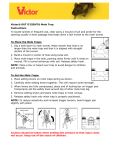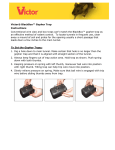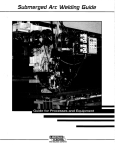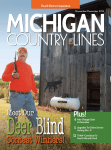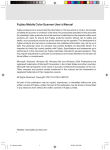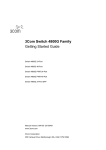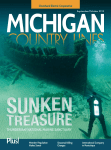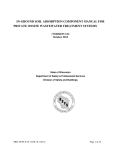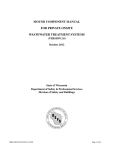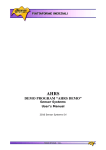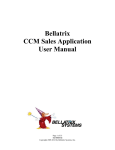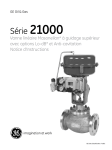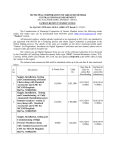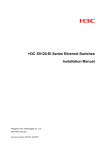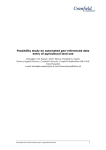Download Minimum Requirements for Alternative On
Transcript
DRAFT www.lmasdhd.org Luce County Administrative Office 14150 Hamilton Lake Road Newberry, MI 49868 (906) 293-5107 Fax (906) 293-5453 Mackinac County 749 Hombach Street St. Ignace, MI 49781 (906) 643-1100 Fax (906) 643-0239 Minimum Requirements for Alternative On-Site Sewage Treatment Systems Technical guidance manual per Article 1.0, Section 1.5 of the LMAS District Health Department Superior Environmental Health Code Home Health & Hospice (906) 643-7700 Fax (906) 643-7719 Alger County E9526 Prospect Street Munising, MI 49862 (906) 387-2297 Fax (906) 387-2224 Schoolcraft County 300 Walnut St., Room 155 Manistique, MI 49854 (906) 341-6951 Fax (906) 341-5230 Delta County Bay Shore Home Nursing 524 Ludington St., LL102 Escanaba, MI 49829 (906) 789-1284 Fax (906) 789-1445 Menominee County Bay Shore Home Nursing 1320 First Street Menominee, MI 49858 (906) 863-1211 Fax (906) 863-3352 Date of Draft: January 8, 2009 Date of Board Approval: Home Health & Hospice ٠ Environmental Health ٠ Personal & Family Health ٠ Community Health Services Minimum Requirements for Alternative On-Site Sewage Treatment Systems Page 1 of 84 DRAFT Preface The minimum requirements set forth in this document were developed by the LMAS District Health Department, Environmental Health Division. The minimum requirements contained in this document have been development for district wide application of alternative methods of residential sewage treatment and commercial systems discharging less than 1000 gpd. This is a working document and modifications may be made as deemed necessary by the LMAS District Health Department. Minimum Requirements for Alternative On-Site Sewage Treatment Systems Page 2 of 84 DRAFT MINIMUM REQUIREMENTS FOR ALTERNATIVE ON-SITE SEWAGE TREATMENT SYSTEMS (UPDATES AND PAGE NUMBERS NEEDED) Table of Contents I. Alternative On-Site Sewage Treatment Systems A. General Information B. Definitions II. Site Criteria A. Parcel Size B. Isolation Distances C. Topography D. Minimum Soil Conditions III. Site Preparation IV. Septic Tank Requirements V. Dosing Chamber and Effluent Pump Requirements A. Dosing Chamber B. Effluent Pump VI. Moratorium 4 4 VI. Design Parameters for Alternative Treatment Not Utilizing Secondary Treatment A. Description B. Conditions for Application Submittal C. Sewage Treatment Components a. Site Preparation b. Septic Tank c. Dosing Chamber and Effluent Pump d. Mound Components D. Moratorium VII. Design Parameters for Systems Utilizing Secondary Treatment A. Description B. Conditions for Application Submittal C. Design Approval D. Deed Restriction E. Sewage Treatment Components a. Secondary Treatment Unit b. Dispersal Mound Components i. Fill Requirement ii. Sizing Minimum Requirements for Alternative On-Site Sewage Treatment Systems Page 2 of 84 DRAFT iii. Side Slope iv. Observation Ports F. Start-up G. Maintenance and Monitoring H. Noncompliance Monitoring IX. Seasonal Use Requirements for Systems Utilizing Secondary Treatment A. Purpose B. Site Description X. Permitting XI. Limitation of Responsibility XII. Final Inspections and Approval to Use System XIII. Revocation of Approval XIV. Disclaimer XV. Product Distribution and Use XVI. Becoming an Approved Distributor/Installer XVII. Becoming an Approved Maintenance Service Provider XVIII. Licensed Septic Installer Registration Process APPENDICES Appendix A Specifications for Geo-Textile Fabric Used in On-Site Sewage Systems Appendix B Isolation Distances Appendix C Pressure Mound Systems Appendix D Submittal Checklist for Alternative Treatment Appendix E Determining If The Site Is Too Wet To Begin Construction Appendix F Procedure for Qualitative Field Test of Sand Cleanliness Appendix G Typical Observation Port Appendix H Approved Distributors/Installers of Secondary Treatment Units Appendix I Individuals Approved as Qualified Maintenance Providers Minimum Requirements for Alternative On-Site Sewage Treatment Systems Page 3 of 84 DRAFT Appendix J Mound Design Worksheet I. Alternative On-Site Sewage Treatment Systems A. General The minimum requirements set forth in this document apply to residential building sites and commercial systems discharging less than 1000 gpd requiring on-site sewage treatment and disposal for compliance under the LMAS District Health Department Superior Environmental Health Code. The provisions of Section 5.7.1 (2) Alternative Sewage System shall apply in the event that a site does not meet the minimum requirements set forth in Section 5.7.1. However, alternative treatment systems are NOT viable options for every site. Some sites are unfortunately unsuitable for the construction of a home. These requirements do not apply to commercial sites (this may need clarification) regulated by the Michigan Criteria for Subsurface Sewage Disposal. Subdivisions, site condominiums, and land divisions under one acre in size shall comply with the Michigan Department of Environmental Quality (MDEQ) Administrative Rules for On-Site Water Supply and Sewage Disposal for Land Divisions and Subdivisions. B. Definitions Alternative Treatment System A treatment and disposal system which is not a conventional system and provides for an equivalent or better degree of protection for public health and the environment than a conventional system. Basal Area The effective undisturbed natural soil surface area available to transmit the treated effluent from the sand fill media into the original receiving soils. Conventional Sewage System An on-site sewage system containing a septic tank used in conjunction with absorption trenches or an absorption bed that utilizes gravity distribution. The effective soil depth or depth to seasonal high water table must be a minimum of twenty-four inches (24”) from the natural grade in stratified sand, gravel, medium sand; eighteen inches (18”) in fine sand, loamy sand; twelve inches (12”) in sandy loam, loam, silt loam, sandy clay loam. Design Consultant The person responsible for designing the construction plans for alternative on-site sewage treatment systems. This can include (depending on type of system): Michigan Registered Sanitarian, Professional Minimum Requirements for Alternative On-Site Sewage Treatment Systems Page 4 of 84 DRAFT Engineer specializing in environmental or sanitary wastewater treatment, LMAS approved secondary treatment distributor/installer, or LMAS licensed septic installer. Elevated Mound (pump and dump) An alternative method of on-site sewage treatment and disposal in which sand fill media is laid on top of properly prepared original soil surface. The sand fill media uses vertical separation to provide the necessary treatment. Pumps are utilized in this type of system. The effluent out of the septic tank flows by gravity to the dosing chamber where it is pumped up to the absorption system installed on top of the sand fill. The effluent then flows by gravity throughout the laterals of the absorption system. The entire system is not pressurized. Geo-textile Fabric A non-woven fabric that is installed between the aggregate and soil cover used to impede or prevent the movement of sand, silt, and clay into aggregate/filter media. Required specifications for use in absorption systems are found in Appendix A. Gravity Mound An alternative method of on-site sewage treatment and disposal in which sand fill media is laid on top of properly prepared original soil surface. The sand fill media uses vertical separation to provide the necessary treatment. Pumps are not utilized for this type of system. The effluent out of the septic tank flows by gravity to the absorption system installed on top of the sand fill. Greenbelt Area The area measured horizontally down slope from the edge of the final treatment system, which is maintained undisturbed prior to, during, and after construction so as not to impede lateral movement of effluent. A representative of the LMAS District Health Department. This may include: the Health Officer, Environmental Health Director, and/or Sanitarian. Health Officer Limiting Layer Any horizon or condition in the soil profile or underlying strata, which will interfere in any way with the treatment of sewage effluent before entering the ground water table. Such horizons include hardpans, fragipans, clay layers, compacted soils, bedrock, saprolite, clay content soils, and permanent and Minimum Requirements for Alternative On-Site Sewage Treatment Systems Page 5 of 84 DRAFT perched ground water tables, which may be visible by mottled soil. Mottled soil A soil that is marked with spots or blotches of contrasting color is usually caused by saturation for some period during a normal year, unless it is artificially drained. Pressure Distribution An alternative method of on-site sewage treatment and disposal in which a specified sand fill media is laid on top of a properly prepared original soil surface. The pressure distribution system and wastewater absorption system (distribution cells), consisting of small diameter pipes uniformly distributing effluent, are then placed entirely within the filter media at such a level that the desired vertical separation to provide the necessary treatment exists. II. Site Criteria A. Purpose – This technical guidance manual is established for sites that were evaluated by LMAS staff to be unsuitable for conventional sewage disposal and treatment. If additional site work is needed, an LMAS Sanitarian shall accompany the design consultant to verify soil work performed. Backhoe cuts are required; augered borings are unacceptable. B. Parcel Size 1. The parcel size shall be a minimum of one (1) acre in size. Consideration will be given to lots that are less than one acre in size under the following conditions: a. Lot was split prior to July 28, 1997. b. All isolation distances and setback requirements can be met. c. Replacement area is available C. Isolation Distances 1. Standard minimum isolation distance requirements set forth in the LMAS District Health Department Superior Environmental Health Code shall be observed. 2. Reductions to these isolation distances may be allowed under a variance for existing homes where a “change in use” that will result in an increase of water use is not proposed. a. Variances will be reviewed under Article 8 of the LMAS District Health Department Superior Environmental Health Code. 3. The alternative system shall be constructed such that the bottom of the absorption system and/or tank seams are at least one foot above the 100 year floodplain elevation. Minimum Requirements for Alternative On-Site Sewage Treatment Systems Page 6 of 84 DRAFT 4. Construction shall no be allowed within 10 feet of easements and right-ofways. 5. The applicant is responsible for contacting other permitting agencies prior to obtaining any permits from the LMAS District Health Department. 6. Isolation from the absorption system shall be measured from the perimeter of stone. D. Topography 1. Areas with 12% or greater slope are to be avoided. 2. Systems should not be installed where extensive cut and fill is required when other viable options exist. These earth moving practices destroy the natural soil structure which is relied upon for proper system operation. 3. Systems are not to be installed at the base of slopes unless surface water draining toward the system is diverted. 4. Tank(s) must placed a minimum of 10 feet and absorption systems shall be placed a minimum of 20 feet from the top edge of steep slopes (25% or greater). Greater distances may be required if site conditions warrant. 5. On sloping sites (i.e., those with slopes > 2 %) it can be expected that flow will move laterally down gradient. So as to not to adversely impede this lateral movement, a suitable downslope greenbelt area shall be provided. The greenbelt area is to be measured from the toe of the side slope of the distribution mound and located within property boundaries. The minimum required greenbelt area varies based on soil structure. Soil Structure Medium sand Fine sand/Loamy Sand Required Downslope Greenbelt (feet) Not Required 10 Very Fine Sand/Sandy Loam 20 Loam/Sandy Clay Loam 30 Clay Loam/Silty Clay Loam Silty Clay/Sandy Clay/Clay 40 Unsuitable E. Minimum Soil Conditions 1. The effective soil depth or depth to seasonal high water table/limiting layer must be a minimum of six inches (6”) from natural grade. III. Site Preparation A. Ultimate success or failure of a mound also relies on a clear communication and understanding of basic site preparation and construction principles. Critical issues include: a. Proper procedures must be followed to protect the mound area including required greenbelt area during and after construction. After Minimum Requirements for Alternative On-Site Sewage Treatment Systems Page 7 of 84 DRAFT b. c. d. e. establishing a suitable location for the mound and replacement area including greenbelt area, it should be suitably fenced or otherwise unmistakably identified to prevent further disturbance until actual construction can occur. Site planning resulting in a location for the mound that is isolated from other anticipated home construction activities is encouraged. Soil smearing and compaction, which can reduce infiltration capacity, will occur if soils are worked on when wet. Construction activities should be scheduled only when soils are sufficiently dry. Acceptable soil moisture content of the soils to a depth of one foot should be evaluated by rolling a sample of soil between the hands. If the soil can be rolled into a ¼ inch or smaller “wire” it is considered too wet and should be allowed to dry before preparing. See Appendix E. Excessive vegetation should be removed from the mound basal area. Trees should be cut flush to the ground and other vegetation over six inches (6”) in length should be mowed and cut vegetation removed. Where an excessive number of stumps and large boulders are encountered, the absorption area should be enlarged or an alternative site should be selected. The entire basal area of the mound should be suitably prepared by roughening in a ridge and furrow fashion with ridges following the contours. Methods that can be considered for roughening include chisel teeth fastened to the backhoe bucket, plowing with a multiple bottom agricultural chisel plow, or moldboard plow. Rototilling is not acceptable. Sand fill material should be applied immediately after roughening and prior to any subsequent precipitation. Cleanliness of sand fill should be checked prior to installation. Placement of fill material then is to be accomplished from the end and upslope sides utilizing a tracked vehicle or equipment with adequate reach to minimize soil compaction. A minimum of six inches of fill material should be maintained below the tracks to minimize compaction. Wheeled vehicles should be prevented from travel over the mound basal area and downslope greenbelt area. Total depth of fill shall be established based on a benchmark provided by the design consultant on the design plan. IV. Septic Tank Requirements a. Tank requirements are established in Section 5.12 of the LMAS District Health Department Superior Environmental Health Code. If conditions exist that will not allow for the first tank to be sized at 1000 gallons, a variance shall be applied for during the application process that will indicate how the required capacity will be maintained. b. Garbage grinder (disposal) use is prohibited on systems utilizing secondary treatment. c. An effluent filter shall be required on the outlet baffle of the last septic tank (if more than one) with the handle extended to within 12” of the top of the riser. It is recommended that a minimum size filter of Minimum Requirements for Alternative On-Site Sewage Treatment Systems Page 8 of 84 DRAFT d. e. f. g. 6” diameter be used. An effluent filter is not required on systems utilizing secondary treatment. Watertight, securable riser to grade is required for the outlet hatch over effluent filter. Septic tanks and dosing chambers shall not be placed within natural swales or other areas of natural water movement. The septic tank, dosing chamber, and/or secondary treatment unit shall be placed on a stable, level surface. A minimum of 4 inch thickness of sand or granular bed overlaying a firm and uniform base is required. Backfill in uniform layers less than 24 inches thick. Backfill should be free of any large stones (greater than 3 inches) or other debris. Sites with silty soils, high water table or other poor bearing characteristics must have specifically designed bedding and bearing surfaces to prevent settling. The septic tanks and dosing chambers shall be installed so that any seam is a minimum of 6” above water table. V. Dosing Chamber and Effluent Pump Requirements (this section should be reviewed by electrical inspector) a. Dosing Chamber i. The dosing chamber shall have a minimum capacity equal to that (or larger) of the septic tank, allowing for at least one (1) day of reserve storage of effluent after the high water alarm is activated due to a pump or float failure. ii. Schedule 40 Polyvinyl Chloride (PVC) pipe shall be used between the septic tank and the dosing chamber. iii. Consideration for a weep hole may be necessary depending on the distance between the dosing chamber and the filter media. If a weep hole is not installed, the discharge pipe should be installed below the frost line with a check valve in the discharge line. b. Effluent Pump i. Pump size and make shall be determined by the design consultant and included on the plans submitted to LMAS. 1. All electrical components and connections must be inspected in accordance with state or local codes. 2. Timers/control panels appropriate to the design of the system shall be installed. Timers/control panels are used to assure proper functioning of the mechanics of the system, prevent overloading of the filter media, and reduce odor production. A low level off control must be installed in conjunction with the timer. A visual alarm shall be installed. ii. A quick union disconnect shall be installed in the riser (required) of the dosing chamber to remove the pump if Minimum Requirements for Alternative On-Site Sewage Treatment Systems Page 9 of 84 DRAFT necessary. This shall be located within 12” of the top of the riser. iii. Grinder pumps are regulated by Plumbing as they are installed prior to the septic tank. VI. Moratorium A. A moratorium on installations will exist between October 15th and June 1st without express written approval from the LMAS District Health Department and the design consultant B. Installation of the alternative treatment system is limited to certain dry times of the year as approved by the LMAS District Health Department and design consultant. The issuance of a sewage disposal permit does not guarantee the septic system can be installed to correlate with occupying the dwelling. VII. Design Parameters For Alternative Treatment Not Utilizing Secondary Treatment A. Description A soil absorption system consisting of a septic tank, dosing chamber (if applicable), and an elevated absorption system (mound). To adequately treat wastewater, mounds should be as long and narrow as the site permits, regardless of flat or sloping topography. A long, narrow slope will minimize the “mounding” of the groundwater table under the absorption bed. Treatment is further enhanced by using pressure distribution to uniformly apply the septic tank effluent over the mound bed several times per day. Proposals for pressure distribution shall refer to the DEQ Pressure Mound Guidance (Appendix C). B. Conditions for Application Submittal 1. Provide a scaled site plan detailing the proposed work along with the LMAS District Health Department application form – refer to Submittal Checklist for Alternative Treatment, Appendix D. iv. Plans shall be at least 8 ½” x 11” in size and shall be legible, clear and permanent copies. v. Plans shall include name of person who prepared plan and shall be stamped if prepared by a Michigan Registered Sanitarian or Professional Engineer vi. Signed copy of “Submittal Checklist for Alternative Treatment” - see Appendix D 2. A Michigan Registered Sanitarian, Professional Engineer specializing in environmental or sanitary wastewater treatment, or licensed sewage system installer registered with LMAS to design, install and monitor construction of alternative treatment systems shall provide design for each specific application. 3. LMAS shall conduct a review of all application/design plan submittals within 30 days of receipt of all required items. C. Sewage Treatment Components Minimum Requirements for Alternative On-Site Sewage Treatment Systems Page 10 of 84 DRAFT 1. Mound Components b. Fill Requirements Include: i. The texture of the fill material shall be a stratified sand and gravel or medium sand with a permeability rate of from 3-10 min/in. A qualitative field check to assess the cleanliness of the sand delivered to the construction site should be conducted (see Appendix F ). ii. Fill shall be free of debris, stones, frozen clods, or ice. iii. The material shall be compacted to avoid settling (or allowed to settle through one fall-winter-spring time period). Settling through the fall-winter-spring is the recommended method of compaction. Compaction of fill can be accomplished by utilizing only tracked equipment. iv. Depth of Fill – The depth of fill must be such that the bottom of the absorption area is isolated > 4 feet above the established high ground water elevation or limiting layer with the exception of pressure distribution. Total depth of fill shall be established based on a benchmark provided by the design consultant on the design plan. c. Sizing i. For mounds constructed with 4 ft of fill, sizing will be based on the permeability rate of 3-10 min./in. Mound (Gravity and Elevated) System Sizing Requirements Fill Sand Permeability Stratified sand and gravel, Med. sand ii. Application Rate gpd/ft.2 Minimum Absorption Area (ft. 2/Bedroom) in/hr min/in Bed Trench Bed Trench 20-6.0 3-10 .75 N/A 200 N/A For mounds utilizing natural soil to achieve the minimum 4 ft vertical separation, the following permeability rates will be used. Mound Sizing Requirements Native Soil Texture/ Structure Permeability in/hr min/in Application Rate gpd/ft.2 Bed Minimum Requirements for Alternative On-Site Sewage Treatment Systems Trench Minimum Absorption Area (Ft. 2/Bedroom) Bed Trench Page 11 of 84 DRAFT Fine sand Loamy sand 6.0-3.0 11-20 .5 NA 300 NA Sandy loam, Loam 3.0-2.0 21-30 .375 NA 400 NA Silty loam, Sandy clay loam 2.0-1.35 31-45 .3 NA 500 NA Clay loam, Silty clay loam Silty clay loam Silty clay, Clay d. Berm – A berm shall be constructed around the perimeter of the absorption system. The berm shall be constructed of adequate size and texture to ensure optimum absorption system function. Soil texture shall be the same as required for fill material (stratified sand and gravel or medium sand). The size of the berm will be dependent on the type of native soil. i. Extend a minimum of 4 ft beyond all sides of the absorption system on sites where the native soil has a permeability greater than or equal to 3 inches per hour. ii. Extend a minimum of 10 ft beyond all sides of the absorption system of sites where the native soil has a permeability less than 3 inches per hour. e. Taper – The taper is the slope surrounding the berm. Soil texture shall be the same as required for fill material (stratified sand and gravel or medium sand). The soil shall be evenly graded from the top of the berm to the natural soil surface with a slope of 3:1 (three horizontal to one vertical). For mounds that are constructed within a maintained lawn it is highly recommended that a slope of 4:1 or 5:1 be installed. Final grading of the mound area should divert surface water drainage away from the mound. f. Observation Ports – At least one observation port to gauge ponding depth in the absorption field is necessary. (see Appendix G) g. Cover i. Geo-textile fabric shall be used between the top of the stone and soil cover. (see Appendix A) ii. The absorption area shall be covered with sufficient suitable soil with a permeability > 3.0 inches/hour to Minimum Requirements for Alternative On-Site Sewage Treatment Systems Page 12 of 84 DRAFT maintain vegetation growth and seeded/mulched upon completion. If system is constructed after September 15th, a vegetative cover must be provided. Cover may consist of sod, mulch, straw or other suitable material to prevent freezing. VIII. Design Parameters for Systems Utilizing Secondary Treatment A. Description Manufactured and packaged mechanical treatment devices that provide additional biological treatment to sewage producing an effluent of significantly better quality than that of septic tank effluent. Because of the significant reduction in biological oxygen demand and total suspended solids that occur in the secondary treatment unit, the soil is relied upon more for dispersal capabilities rather than treatment of effluent. The reduced organic concentration in the treated effluent allows for a smaller sized dispersal system to be relied upon to accomplish hydraulic dispersal of the treated effluent. B. Conditions for Application Submittal 1. Provide a scaled site plan detailing the proposed work along with the LMAS District Health Department application form – refer to Submittal Checklist for Alternative Treatment, Appendix D. vii. Plans shall be at least 8 ½” x 11” in size and shall be legible, clear and permanent copies. viii. Plans shall include name of person who prepared plan and shall be stamped if prepared by a Michigan Registered Sanitarian or Professional Engineer ix. Signed copy of “Submittal Checklist for Alternative Treatment”. 2. A Michigan registered sanitarian, professional engineer specializing in environmental or sanitary wastewater treatment, or an LMAS approved secondary treatment distributor/installer shall provide design for each specific application. i. No system shall be designed in a manner which does not meet the manufacturer’s minimum recommendations. 3. Copy of the signed alternative treatment system contract along with proof of filing . . .Filing should not take place until plan has been approved. Filing must occur prior to issuance of permit 4. Maintenance contract signed by both the owner and service provider. 5. Plans will not be reviewed until all required components described herein are submitted with the application fee. LMAS shall conduct a review of all applications/design plan submittals within 30 days of receipt and will issue a written response to the applicant. Minimum Requirements for Alternative On-Site Sewage Treatment Systems Page 13 of 84 DRAFT D. Deed Restriction E. Sewage Treatment Components 1. Secondary Treatment Unit a. Any secondary treatment units that are not on the most current LMAS District Health Department approved list will not be considered under this manual (see Appendix H). Approval for use in the district is required prior to the application process. Product must meet the minimum requirements set forth in XV. Product Distribution and Use. b.The secondary treatment unit shall be placed on a stable, level surface. A minimum of 4 inch thickness of sand or granular bed overlaying a firm and uniform base is required. Backfill in uniform layers less than 24 inches thick. Backfill should be free of any large stones (greater than 3 inches) or other debris. Sites with silty soils, high water table or other poor bearing characteristics must have specifically designed bedding and bearing surfaces to prevent settling. c. Units that will be located within a saturated soil condition must be designed in a manner that considers all other structural issues including, but not limited to, buoyancy and structural effects on the treatment unit. d. A sample port shall be installed such that a sample of the treated effluent can be easily taken without contamination to the sample bottle. The sample port shall be located on the outlet side of the unit between the unit and the dispersal mound. e. Only an Approved Alternative System Distributor/Installer shall install the secondary treatment system and must be present at all times during the installation. No work on the secondary treatment unit may be conducted unless under the direct supervision of an Approved Alternative System Distributor/Installer. f. All secondary treatment systems shall be equipped with a telemetry control panel which is attached to an internet based interface that provides continuous remote monitoring, information management and control of the secondary treatment unit. Sites that do not have a telemetry control panel must use an active phone line equipped with an auto dialer to notify the authorized service provider of alarm conditions, including if power to any of the system equipment is disconnected. The system should also include a control panel that tracks, at a minimum, pump elapsed time, cycle counts and high level alarm counts or other means to determine flow through the system and other system Minimum Requirements for Alternative On-Site Sewage Treatment Systems Page 14 of 84 DRAFT information for troubleshooting purposes, as recommended by the manufacturer. 2. Dispersal Mound Components b. Fill Requirements Include: i. The texture of the fill material shall be a stratified sand and gravel or medium sand with a permeability rate of from 3-10 min/in. A qualitative field check to assess the cleanliness of the sand delivered to the construction site should be conducted (see Appendix F ). ii. Fill shall be free of debris, stones, frozen clods, or ice. iii. The material shall be compacted to avoid settling (or allowed to settle through one fall-winter-spring time period). Settling through the fall-winter-spring is the recommended method of compaction. Compaction of fill can be accomplished by utilizing only tracked equipment. iv. Depth of Fill – The depth of fill must be such that the bottom of the absorption area is isolated > 2 feet above the established high ground water elevation or limiting layer. Total depth of fill shall be established based on a benchmark provided by the design consultant on the design plan. c. Sizing i. For dispersal mounds utilizing at least 2 ft of fill sand sizing, will be based on the permeability rate of 3-10 min./in Dispersal Mound System Sizing Requirements Fill Sand Stratified sand and gravel, Med. sand iii. Permeability Application Rate gpd/ft.2 Minimum Absorption Area (Ft. 2/Bedroom) in/hr min/in Bed Trench Bed Trench 20-6.0 3-10 1.3 N/A 115 N/A For dispersal mounds utilizing natural soil sizing, will be based on the following permeability rates: Native Soil Texture/Structure Medium Sand Fine Sand, Loamy Sand Sandy Loam Minimum Requirements for Alternative On-Site Sewage Treatment Systems Gravel/Pipe System gal/ft2/day ft2/bedroom1 1.3 0.9 0.6 115 170 250 Page 15 of 84 DRAFT Loam, Silt Loam Sandy or Silty Clay Loam Clay Loam 0.5 0.3 0.2 300 500 750 d. Side Slope – The final side slope on the dispersal mound shall be 4:1 or flatter. Final grading of the mound area should divert surface water drainage away from the mound. e. Observation Ports – At least one observation port to gauge ponding depth in the absorption field is necessary. (see appendix G) f. Cover c. Geotextile fabric shall be used between the top of the stone and soil cover. (see appendix A) d. The absorption area shall be covered with sufficient suitable soil to maintain vegetation growth and seeded/mulched upon completion. If system is constructed after September 15th, a vegetative cover must be provided. Cover may consist of sod, mulch, straw or other suitable material to prevent freezing. I. Start-up 1. The Approved Alternative System Installer shall be present at the time of start-up. J. Maintenance and Monitoring 1. The owner shall at his/her sole expense comply with a specific maintenance, monitoring and inspection program specified by the LMAS District Health Department to ensure the optimum operation of the treatment system. 1. Each secondary treatment system shall have an operation and maintenance contract with an approved maintenance service provider for the life of the system. Approval of the contract shall be made by the department prior to the issuance of the permit. A list of approved maintenance service providers is available upon request. In the event the maintenance service provider under contract fails to perform, the property owner is responsible to make arrangements with another approved maintenance service provider who is qualified to maintain their particular type of treatment unit. If there are no other maintenance service providers available to provide service to a particular brand of treatment unit, then the homeowner will be responsible to contact the manufacturer in an attempt to continue with the required service. 2. Failure to maintain a maintenance contract is a violation of the permit and will result in enforcement action against the property owner and revocation of the operating permit. 3. All treatment systems shall be maintained according to the manufacturer’s specifications. 4. The distributor/installer shall provide the manufacturer’s operation and maintenance manual to the homeowner. Minimum Requirements for Alternative On-Site Sewage Treatment Systems Page 16 of 84 DRAFT 5. Secondary treatment systems shall be inspected by an Approved Maintenance Service Provider on the following schedule, at a minimum: a. Once within 30 days following initial system start-up. b. Twice per year for the first 2 years of operation (excluding the inspection required within 30 days of start-up); once per year thereafter. c. A meeting with a new owner is recommended at the time of transfer of the property. The LMAS District Health Department should be notified of this meeting and invited to participate. The provider shall provide any future purchaser of the property with a copy of this guidance manual, manufacturer installation, operation, and maintenance manual, deed notices, etc. and obtain their approval via notorized signature prior to entering into a contract of sale for the subject property. d. Additionally, as required by the manufacturer. 6. The maintenance contract must be signed by the maintenance service provider and the homeowner indicating they have read the contract and understand all components contained within. a.A copy of the initial contract shall be submitted to LMAS as part of the permitting process. b. All maintenance service providers are to provide to LMAS copies of all renewed contracts and submit a list of property owners who have discontinued or not renewed maintenance contracts during the previous year. This information shall be submitted to LMAS between January 1 through February 28th of each year. i. Within 30 days of notification, LMAS shall advise each property owner with lapsed contracts to renew. Owners will be given 60 days to comply. ii. Failure to comply with the requirements will result in enforcement action. 7. Minimum contract reporting requirements a. All secondary treatment systems need servicing consistent with the manufacturer’s recommendations to assure long-term system performance. b. At a minimum the inspection report shall include: i. A walk-over of the drainfield and noted conditions ii. Reporting of conditions observed in the observation port located in the drainfield. iii. Condition and water level of septic tank iii. Condition of the treatment unit i. Unusual odor ii. Appearance of scum layer Minimum Requirements for Alternative On-Site Sewage Treatment Systems Page 17 of 84 DRAFT iii. Clarity iv. Condition of filters, if applicable iv. Alarm check v. Filter cleaning vi. Check of all electrical and/or mechanical components include pump cycle and run time meters. vii. Homeowner education in: 1. Product Use 2. Proper maintenance of system viii. Number of person occupying the dwelling ix. List of corrections or alterations that were made during the visit x. Septage pumping records shall be submitted each time any of the tanks are pumped including, septic tank(s), secondary treatment tank, and/or pump tank. 1. Provider shall obtain from homeowner. 9. Maintenance Service Report Submittal to LMAS a. Providers shall submit copies of inspection report(s) of system inspections that includes a minimum of the information noted above along with a year end telemetry report to LMAS between January 1 through February 28th each year. b. Reports must include information necessary to identify it to the correct property. This shall include, at a minimum: date of inspection, owners name, property information including Town (T), Range (R), and Section along with property ID number. c. It is recommended that providers submit their report forms to LMAS for review to ensure that all necessary information is included. This should be done prior to using the form. K. Noncompliance Monitoring 1. The owner is responsible for the proper operation and performance of the system. If additional monitoring is required the owner shall be responsible for all costs associated with this monitoring and/or system repair. 2. In the event that the secondary treatment unit or associated dispersal component(s) are found to be in noncompliance with the requirements in which it was permitted, the following actions must be taken at the owners expense: a. The approved maintenance provider shall inspect the system in the presence of LMAS staff and correct any dieficiencies noted. b. If LMAS deems necessary, samples shall be taken to determine compliance. These samples include, but at not limited to: BOD, TSS, and FC. Total Phosphorous shall be sampled if the system is within 500 ft of a body of water. c. The maintenance service provider shall report to the department at the completion of inspection and/or servicing. Minimum Requirements for Alternative On-Site Sewage Treatment Systems Page 18 of 84 DRAFT d. Use of the system may need to be discontinued if the system malfunctions and is found to be non-repairable, or is noncompliant with the permit and results in an imminent health hazard. 3. If compliance with the conditions in which the secondary treatment unit and/or associated dispersal component(s) was permitted under cannot be achieved, or if LMAS determines that the Superior Environmental Health Code has been violated, a notice of violation will be issued to the owner. 4. LMAS shall have access to the property during regular business hours in order to conduct surveillance monitoring. a. Surveillance monitoring resulting from noncompliance may be charged a monitoring fee in accordance with the department fee schedule. b. LMAS shall be allowed to initiate required maintenance at the owners expense if non-compliance with the permit or Superior Code results in an imminent health hazard. IX. – Seasonal Use Requirements for Systems Utilizing Secondary Treatment A. Purpose These requirements are for seasonal use facilities as outlined below. Site conditions not covered by the following must be forwarded to the manufacturer for recommendations to meet the particular site conditions. Use of the facility shall be indicated on the application along with requirements to meet the particular situation. LMAS reserves the right to deny a permit on sites with infrequent occupancy. B. Site Description 1. Systems not in use for more than one month and less than three months. Electrical power is left on and there are not frost conditions. a.Requirements: i. Leave air pump on and system running. 2. Systems not in use more than three months. Electrical power is turned off and there are not frost conditions. a. Requirements: i.While system is operating with the air pump on, remove all material and liquid from the tank. ii. Refill the tank with clean water. iii. Turn off air pump 3. System not in use more than three months. Electrical power is on and there are not frost conditions. a. Requirements: i. Leave air pump on and system running OR ii. While system is operating with the air pump on, remove all material and liquid from tank iii. Refill with clean water iv. Turn off air pump Minimum Requirements for Alternative On-Site Sewage Treatment Systems Page 19 of 84 DRAFT 4. System not in use. Electrical power is turned off and there are frost conditions. a. Requirements: i. While the system is operating with the air pump on, remove all material and liquid from the tank. ii. Turn off air pump iii. Remove all material from septic tank iv. Fill both tanks with clean water to prevent buoyancy. 5. UNDER NO CIRCUMSTANCES SHALL THE AIR PUMP BE TURNED OFF FOR MORE THAN A FEW DAYS WITHOUT REMOVING TANK CONTENTS. 6. During periods of occupancy, the secondary treatment unit must be operated in accordance with the manufacturer’s recommendation and NSF certification. 7. As part of each start-up event, the distributor/installer shall check the unit to ensure that the system is operational. X. Permitting A. Upon completion of the permit application/design review, LMAS shall accept the design, reject the design, require additional information for clarification, or require verification. B. If the permit application/design is not acceptable, LMAS shall notify the applicant in writing and shall state the deficiencies or actions, or both, necessary to bring the design into compliance with the requirements set forth in this document. C. When a completed permit application/design area deemed acceptable, LMAS shall issue a construction permit. XI. Limitation of Responsibility A. Plan approval by LMAS may not be construed as an assumption of any responsibility for the design of the Alternative Treatment System and associated dispersal component(s). B. LMAS does not hold itself liable for any defects in design and/or construction, or for any damages that may result from a specific installation. XII. Final Inspections and Approval to Use System 1. A final inspection shall be conducted by LMAS in accordance Section 5.15 of the LMAS District Health Department Superior Environmental Health Code. During this inspection, LMAS will approve or deny covering of the system. Approval to use the system will not be granted until all required information has been received: e. The Design Consultant shall provide the LMAS District Health Department with written certification that the installed system meets their design and the intent of the minimum requirements contained within this document. Independent third party certification shall be required if the designer and installer are the same individual or related company where a conflict of interest may be present. f. Copy of the final inspection approval from the Michigan Department of Labor – Electrical Division. Minimum Requirements for Alternative On-Site Sewage Treatment Systems Page 20 of 84 DRAFT 2. After all required information has been submitted, LMAS shall issue a final approval/operating permit to the applicant. XIII. Revocation of Approval A. The department may revoke any plan approval under this Section when one or more of the following conditions exists: 1. The location of the system(s) specified in the design is altered. 2. There is an increase in the scope of the project prior to, during, or following construction. 3. LMAS acquires new information indicating that any agency rules or regulations are violated before, during, or after construction. 4. LMAS has reasonable cause to believe that an intentional misrepresentation has occurred. XIV. Disclaimer A. The LMAS District Health Department reserves the right to require special restrictions in addition to those listed herein to insure that an adequate sewage disposal system is installed. These restrictions may be determined on a site specific basis. XV. Product Distribution and Use A. Any new technology proposed within the District not covered under the LMAS District Health Department Superior Environmental Health Code must go through an approval process. B. Any devises considered secondary treatment shall be NSF approved with the classification of Class I (Standard 40, July 2000 or subsequent versions) to achieve a 90% reduction or better in biological oxygen demand and suspended solids. Treated effluent must meet the following criteria: 1. BOD less than or equal to 30 mg/L 2. TSS less than or equal to 30 mg/L 3. Total inorganic nitrogen less than or equal to 25 mg/L 4. For discharges within 500 ft of a body of water, total inorganic nitrogen less than of equal to 10 mg/L and total phosphorous less than or equal to 2 mg/L. C. All secondary treatment systems shall be equipped with a telemetry control panel which is attached to an internet based interface that provides continuous remote monitoring information management and control of the secondary treatment unit or shall use an active phone line equipped with an auto dialer to notify the authorized service provider of alarm conditions, including if power to any of the system equipment is disconnected. The system should also include a control panel that tracks, at a minimum, pump elapsed time, cycle counts and high-level alarm counts or other means to determine flow through the system and other system information for troubleshooting purposes. D. The manufacturer must provide assurance that continued consultation and service will be provided in the event that the distributor should fail to meet with required oversight or in the event that the distributor should go out of business. E. The manufacturer/distributor must demonstrate the capabilities of providing adequate training and certification of installers and maintenance Minimum Requirements for Alternative On-Site Sewage Treatment Systems Page 21 of 84 DRAFT F. G. H. I. providers. They must also be conveniently available for consultation both on and off site. The manufacturer must demonstrate that they are a viable company with proven technical expertise in the wastewater industry and capable of providing assurance of product reliability and backing in the event of product poor performance. The manufacturer must have an established hands-on training program for prospective designers, installers, and service providers in the proper design, installation, and maintenance of their system. Video training is unacceptable. The manufacturer/distributor must demonstrate that replacement parts are readily available for all mechanical components of the product(s). If approved, failure to meet and maintain these minimum requirements for alternative on-site sewage treatment systems may result in product acceptance being revoked in LMAS. XVI. Becoming an Approved Distributor/Installer A. All individuals/companies interested in distributing and/or installing an alternative treatment system within the LMAS District Health Department must go through LMAS product review as noted in Section XV above. If product use is approved by LMAS, these individuals must: 1. Submit letter of interest to LMAS along with proof of training, location of training, number of hours of training, experience with wastewater treatment systems, equipment experience, etc. 2. Include manufacturer certification. 3. Any other information necessary for LMAS to make a decision B. Once approved, future training to update siting, installation, start-up and documentation procedures is required at a frequency recommended by the manufacturer. C. Continuing Education Requirements – once approved, a minimum of eight (8) education units shall be obtained annually. At least 6 of the 8 credits shall be obtained through training sessions for alternative technology, conferences pertaining to sewage disposal and treatment. Two (2) of the required 8 credits can come from publication subscriptions pertaining to sewage disposal and treatment. 1. The provider shall submit proof of continuing education to LMAS annually between January 1 through February 28th. 2. If this information is not supplied to LMAS within the required timeframe, the provider will be removed from the list of approved maintenance service providers. In order to be placed back on the list, a penalty fee along with proof of continued education units will be required. If a year or more has lapsed, then provider will have to return for manufacturer training. XVII. Becoming an Approved Maintenance Service Provider Minimum Requirements for Alternative On-Site Sewage Treatment Systems Page 22 of 84 DRAFT A. “Qualified maintenance provider” means a person who, by possession of a recognized degree or certificate of professional standing, or who by extensive knowledge, training, and experience, has successfully demonstrated the ability to solve or resolve problems relating to the subject matter and work. B. Interested individuals shall meet the definition noted above. Individuals shall submit a letter of interest along with proof that they have completed training in the proper testing, maintenance, troubleshooting, and cleaning from the unit manufacturer. Continued manufacturer training shall occur at a frequency recommended by the manufacturer. C. The provider will be approved to provide service to only those systems in which certification is held. D. Continuing Education Requirements – once approved, a minimum of eight (8) education units shall be obtained annually. At least 6 of the 8 credits shall be obtained through training sessions for alternative technology, conferences pertaining to sewage disposal and treatment. Two (2) of the required 8 credits can come from publication subscriptions pertaining to sewage disposal and treatment. 1. The provider shall submit proof of continuing education to LMAS annually between January 1 through February 28th. 2. If this information is not supplied to LMAS within the required timeframe, the provider will be removed from the list of approved maintenance service providers. In order to be placed back on the list, a penalty fee along with proof of continued education units will be required. If a year or more has lapsed, then provider will have to return for manufacturer training. XVIII. Licensed Septic Installer Registration Process A. Interested individuals shall submit a letter of interest along with proof of experience in design and installation of systems not utilizing secondary treatment. Individuals shall also indicate knowledge in design of pump systems. Individuals shall specify type of systems they will be able to design. Minimum Requirements for Alternative On-Site Sewage Treatment Systems Page 23 of 84 DRAFT Appendix A Specifications for Geo-Textile Fabric Used in On-Site Sewage Systems Minimum Requirements for Alternative On-Site Sewage Treatment Systems Page 24 of 84 DRAFT SPECIFICATIONS FOR GEO-TEXTILE FABRIC USED IN ON-SITE SEWAGE DISPOSAL SYSTEMS 1. Geo-textile fabric shall meet the following specifications: a. Strength: 25 PSI b. Air permeability: 500 cfm/sq. ft. c. Water flow: 500 GPM/sq. ft. at 3 inches of head d. Opening size: 70-100 sieve e. Average roll values: unit weight of 1.5 oz./yard squared, permittivity of. 1.0 a second, trapeziod tear of 15lbs 2. Fabric shall not be exposed to sunlight for more than 7 days. 3. Shall be free of defects, flaws, or tears that would alter the strength and filtering properties. 4. Fabric shall be uniform in texture and thickness. 5. Non-woven material 6. Must be labeled as Class 3 Geo-textile material 7. Minimum of 12” (trench) or 18” (bed) of overlap Minimum Requirements for Alternative On-Site Sewage Treatment Systems Page 25 of 84 DRAFT Appendix B Isolation Distances Minimum Requirements for Alternative On-Site Sewage Treatment Systems Page 26 of 84 DRAFT Isolation Distances From / To Residential Well Non Community Well (Type IIB, Type III) Community Well Type IIA Property Lines Foundation Wall Building/Storm/ Subsoil Drains Water Lines Embankments Lakes or Streams Sewer Lines 10 10 Septic Tanks 50 75 Absorption System 50 75 Earth Pit Privies 100 100 Vaulted Privies 50 75 10 200 200 200 200 ---- 10 5 5 10 10 25 10 20 25 10 5 5 ---- 10 10 75 10 20 75 10 25 75 10 10 75 1. As summarized in the above table, the proposed sewage system shall satisfy the following isolation requirements: A. Sewer lines from buildings shall be located a minimum of ten feet (10’) from all water wells. B. Septic tanks or vaulted privies shall be located a minimum of fifty feet (50’) from residential wells; seventy five feet (75’) from Type IIb non-community and Type III water supplies, and two hundred feet (200’) from Type IIa and community water supplies; ten feet (10’) from property lines; five feet (5’) from foundation walls; five feet (5’) from building footing drains, storm drains and/or other subsoil drains; ten feet (10’) from water lines; ten feet (10’) from steep embankments or drop-offs, and seventy-five feet (75’) from lakes, streams or other surface water impoundments. C. The absorption system shall be located a minimum of fifty feet (50’) from residential wells; seventy five feet (75’) from Type IIb non-community and Type III water supplies; two hundred feet (200’) from Type IIa and community water supplies; ten feet (10’) from property lines, ten feet (10’) feet from foundation walls; twenty five feet (25’) from building footing drains, storm drains and/or other subsoil drains; ten feet (10’) from water lines, twenty feet (20’) from steep embankments or drop-offs, and seventy five feet (75’) from lakes, streams or other surface water impoundments. Minimum Requirements for Alternative On-Site Sewage Treatment Systems Page 27 of 84 DRAFT Appendix C Pressure Mound Systems Technical Guidance for Site Suitability, Design, Construction and Operation and Maintenance Michigan Department of Environmental Quality Water Division Minimum Requirements for Alternative On-Site Sewage Treatment Systems Page 28 of 84 DRAFT Pressure Mound Systems Technical Guidance for Site Suitability, Design, Construction and Operation and Maintenance Michigan Department of Environmental Quality Water Division Land Division and Local Health Department Support Program June 2003 Minimum Requirements for Alternative On-Site Sewage Treatment Systems Page 29 of 84 DRAFT PREFACE The technical guidance contained in this document has been developed for statewide application pursuant to R 560.424(2) of the Michigan Department of Environmental Quality Administrative Rules, “On-site Water Supply and Sewage Disposal for Land Divisions and Subdivisions.” This technical guidance represents minimum standards for application of the described alternative method of sewage treatment and disposal for a development site less than one acre, subdivision lots, and site condominium units. The Michigan Department of Environmental Quality supports application of this technical guidance at the full discretion of the local health department having jurisdiction. The standards may be used as minimums at the local level as written or modified to reflect more stringent requirements deemed necessary based on local conditions. Please note that pursuant to R 560.424(3), the specific alternative must be provided for under the regulations of the city, county, or district health department having jurisdiction and formal authorization must be granted by the Michigan Department of Environmental Quality. R 560.424. Alternative methods of sewage treatment and disposal. Rule 424. (1) The department may approve an alternative treatment and subsurface disposal system for a development site less than 1 acre in size or a lot deemed suitable or not suitable for a conventional subsurface sewage system. (2) The department of environmental quality shall provide technical guidance in defining minimum site suitability and design and long-term operation and maintenance requirements considered essential for the proper functioning of specific alternative systems. (3) The owner may utilize an alternative system if the specific alternative is provided for under the regulations of the city, county, or district health department having jurisdiction and if the department of environmental quality has authorized the alternative system’s use. -2Minimum Requirements for Alternative On-Site Sewage Treatment Systems Page 30 of 84 DRAFT TABLE OF CONTENTS Definitions CCCCCCCCCCCCCCCCCCCCCCC.CCCCC..CC. 4 Introduction CCCCCCCCCCCCCCCCCCCCC..CCCCCCCCC 7 Site Suitability CCCCCCCCCCCCCCCCCCCCCCCC.CCC........ 8 Site Evaluation and Planning CCCCCCCCCCCCCCCCCCCCCCC 9 Design CCCCCCCCCCCCCCCCCCCCCCCCC.CCCCC.CC 10 Site Preparation and Construction CCCCCC..CCCCCCCCCCCCC.C 13 Operation and Maintenance CCCCCCCCCCCCCCCCCCCCCCC. 14 Appendix A - Figures and Tables CCCCCCCCCCCCCCCCCCCC.C 16 Figure 1- Mound System Components CCCCCCCCCCCCCCC... 17 Figure 2 - Typical Site Plan CCCCCCCCCCCCCCCCCCCC... 18 Figure 3 - Mound Plan View and Cross Section CCCCCCCCCCCC 19 Figure 4 - MDOT 2NS Sand Fill Gradation CCCCCCCCCCCCCC. 20 Procedure for Qualitative Field Test of Sand Cleanliness CCCCCCC... 21 Figure 5 - Observation Port Example Details CCCCCCCCCCCCC. 22 Table 1 - Allowable Soil Loading Rates CCCCCCCCCCCCCCC.. 23 Table 2 - Minimum Horizontal Isolation Distances CCCCCCCCCCC 24 Appendix B - Design Example CCCCCCCCCCCCCCCCCCCCCC.. 25 Appendix C - Mound Maintenance Visit Checklist CCCCCCCCCCCCCC 29 Appendix D - Mound Design Worksheet CCCCCCCCCCCCCCCCCC. 31 -3Minimum Requirements for Alternative On-Site Sewage Treatment Systems Page 31 of 84 DRAFT DEFINITIONS Alternative System: A treatment and disposal system that is not a conventional system and provides for an equivalent or better degree of protection for public health and the environment than a conventional system. Approved: A written statement of acceptability issued by the local health officer or the Department of Environmental Quality. Basal Area: The effective in situ soil surface area available to transmit the treated effluent from the sand fill media into the original receiving soils. Conventional System: An on-site sewage treatment system consisting of a watertight septic tank and a subsurface soil absorption system with non-uniform distribution of the effluent to subsurface soil trenches or an absorption bed. Cover Material: The material used to cover a mound system, usually selected on its availability, cost, and ability to support vegetation, transfer oxygen, and shed water. Distribution Cell Area: The area within the mound where the effluent is distributed into the fill material. Effluent: Liquid discharged from a septic tank or other on-site sewage system component. Excessively Permeable Soils: Soil that contains a high percentage of coarse to very coarse sands (2.0 mm and larger) and often including fine gravels and/or cobbles. Water passes through the soil very rapidly (i.e., soil permeability < 3 minutes/inch) and internal free water is very rare. Greenbelt Area: The area measured horizontally downslope from the edge of the mound fill, which is maintained undisturbed prior to during and after construction so as not to impede lateral movement of effluent. High Groundwater Elevation: The uppermost part of the soil or underlying material wholly saturated with water. The term includes perched and apparent conditions that are seasonally saturated for a time period in excess of two weeks, or permanently saturated. Hydraulic Linear Loading Rate: The volume of effluent applied per day per linear foot of system along the natural ground contour. Influent: Wastewater flowing into an on-site sewage system component. In Situ Soil: Soil present in the natural or original position. Minimum Requirements for Alternative On-Site Sewage Treatment Systems Page 32 of 84 DRAFT Limiting Layer: High groundwater elevation, soils with an expected permeability above 60 minutes/inch, or bedrock. Original Grade: The natural land elevation which exists immediately prior to the construction of the mound system. Permeable Soil: Soils with a textural classification, according to the U.S. Department of Agriculture Soil Conservation Service classification system, of silt loams, and some silty clay loams that are well structured with expected permeability less than or equal to 60 minutes/inch. Permeability: The ability of soil to transmit liquids through pore spaces in a specified direction, e.g., horizontally or vertically. Pressure Distribution: A system of small diameter pipes uniformly distributing effluent throughout a trench, bed, or chamber. Pressure Mound System: An alternative method of on-site sewage treatment and disposal in which a specified sand fill media is laid on top of a properly prepared original soil surface. The pressure distribution system and wastewater distribution cells are then placed entirely within the filter media at such a level that the desired vertical separation to provide the necessary treatment exists. The fill material provides a measurable degree of wastewater treatment and allows effluent dispersal into the natural soil environment for final treatment. Pump Chamber: A watertight tank or compartment following the septic tank or other pretreatment process that contains a pump, floats, and volume for storage of effluent. Reserve Area: An area of land with site conditions deemed suitable for the installation of a replacement system upon failure of the initial system. Sand Fill: Sand meeting specific criteria regarding particle size and installation technique to ensure adequate wastewater treatment. Sanitary Sewage: Water and contaminants discharged from sanitary conveniences, including bathroom, kitchen, and household laundry fixtures of dwellings, office buildings, industrial plants, commercial buildings, and institutions. Commercial laundry wastes and industrial and commercial processes are not considered sanitary sewage. Septic Tank: A watertight pretreatment receptacle receiving the discharge of sanitary sewage from a building sewer or sewers designed and constructed to permit separation of settleable and floating solids from the liquid, detention and anaerobic/facultative digestion of the organic matter prior to discharge of the liquid. -5Minimum Requirements for Alternative On-Site Sewage Treatment Systems Page 33 of 84 DRAFT Slowly Permeable Soil: Soils with a textural classification according to the U.S. Department of Agriculture Soil Conservation Service classification system of silt loams and some silty clay loams that are well structured with expected permeability above 60 minutes/inch. Soil Compaction: An increase in the soil bulk density and decrease in soil porosity by the application of mechanical forces to the soil that results in a soil that retains less water and resists root penetration. Soils with high clay content are more easily compacted than sandy soils. Soil Loading Rate: The allowable application rate to the basal area required for absorption of effluent based upon soil texture for a given soil structure. Soil Mottling (also known as redoximorphic features): Spots or blotches of contrasting colors, such as, but not limited to, gray or brown or gray and brown colors in close proximity, that are formed in the soil matrix by the processes of reduction, translocation, and oxidation of iron and manganese compounds in soils that have been periodically saturated. Timer-Controlled System: A pressure distribution system where a pump’s “on” and “off” times are preset, discrete time periods. Uniform Distribution: A method of distribution that results in equal distribution of the effluent throughout the distribution network. This will help assure a vertical unsaturated flow regime. Vertical Separation: The total depth of unsaturated soil that exists between the infiltrative surface of a distribution cell and a limiting layer. -6Minimum Requirements for Alternative On-Site Sewage Treatment Systems Page 34 of 84 DRAFT INTRODUCTION When properly sited, designed, constructed, operated and maintained pressure mounds provide a proven effective alternative method of on-site treatment. A pressure mound system relying on subsurface distribution to in situ soils can be an effective solution where site conditions are not suitable for conventional treatment and disposal systems. Typical situations where mound systems might be applied include: Permeable or slowly permeable soils with a high groundwater elevation. Where permeable or slowly permeable soils with a high groundwater elevation prevent the installation of a conventional treatment system, a mound may be an acceptable alternative to provide for final treatment and disposal. Utilizing a mound with pressure distribution of effluent to promote unsaturated flow along with elevating the infiltrative surface to provide vertical separation maximizes final treatment efficiency. Slowly permeable soils without high groundwater. Slowly permeable soils are most effective for final treatment and disposal where the natural soil profile is maintained in an undisturbed condition. Utilizing a mound system with pressure distribution for these sites offers a number of advantages as opposed to attempts to construct a conventional below grade final treatment and disposal system including: Damage to the natural soils during construction including compaction and smearing is minimized. Treated effluent is discharged and dispersed into the uppermost soil horizons, which are typically more permeable. The mound sand fill media provides additional treatment, which minimizes clogging of the slowly permeable soils while maintaining their hydraulic conductivity. Utilizing pressure distribution promotes unsaturated flow resulting in more efficient treatment, extended life of the system and improves overall hydraulic performance by minimizing groundwater mounding. Excessively permeable soils or creviced bedrock. Excessively permeable natural soils or shallow soils over creviced bedrock present distinct concerns related to contamination of groundwater supplies or surface waters. In conjunction with a comprehensive evaluation of site specific environmental and/or public health concerns, mounds may be evaluated as a potential treatment alternative to minimize adverse impacts. -7Minimum Requirements for Alternative On-Site Sewage Treatment Systems Page 35 of 84 DRAFT SITE SUITABILITY Those sites meeting the following criteria for the initial, replacement, and greenbelt areas may be considered for pressure mounds: Soils - undisturbed natural soils only. Historical agricultural activities are not generally considered as disturbance. Soil texture and structure - the most limiting horizon encountered in the upper 18 inches must be a suitable soil texture and structure as shown in Table 1. Permeability of uppermost soil horizon - soils with an estimated permeability of 60 minutes/inch or less based on soil texture and structure. Depth to high groundwater elevation - 18 inches minimum from the undisturbed natural ground surface. The depth to high groundwater elevation shall be confirmed by a soil profile with 6 inches or more of soil without mottling (a.k.a. redoximorphic features) below the “A” horizon (topsoil) or groundwater monitoring in accordance with R 560.423 of the Michigan Department of Environmental Quality Administrative Rules, “On-site Water Supply and Sewage Disposal for Land Divisions and Subdivisions.” Depth to creviced bedrock - 24 inches. Slope - natural ground slope should be < 25 percent in mound area to promote safety of workers during construction. -8Minimum Requirements for Alternative On-Site Sewage Treatment Systems Page 36 of 84 DRAFT SITE EVALUATION AND PLANNING A critical step in the successful application of mound technology is the site evaluation and planning process. This step provides the site specific information necessary to evaluate overall site suitability and is used as the foundation for actual design. Prior to completing the site evaluation, available site specific information related to soils, slopes, etc., should be reviewed in detail. For the majority of counties, USDA soil surveys are a valuable resource in this regard. This information will provide general guidance as to the potential for application of mound technology. After a thorough review of this information, preliminary site plans can be developed and a site evaluation conducted. For each lot where a mound is intended, a minimum of three soil profile evaluations are considered sufficient to delineate the area under investigation for initial, replacement systems, and greenbelt areas and to establish consistency. Soil evaluations should be completed during those time periods where soils are sufficiently dry to avoid damage to the absorption area. In areas of complex soils, additional evaluations may be necessary. Soil evaluations should be completed by observation of shallow soil pits of adequate size, depth, and construction to safely enter and exit the pit and complete a soil profile description. All of the following shall be accurately reported by a competent soil consultant for each soil horizon or layer: Thickness USDA soil textural class Presence of soil mottles or redoximorphic features Soil structure - grade and shape Occurrence of saturated soil, groundwater, bedrock, or disturbed soils Site planning for development sites less than one acre, subdivision lots, or site condominium units must also consider the following features: Property lines and lot lines Slope Required setback distances Existing or proposed structures Existing or proposed wells Surface waters For projects involving multiple lots or units, overall planning should also consider and mitigate any negative impacts from other off-lot development activities, including grading, road construction, and surface water drainage. -9Minimum Requirements for Alternative On-Site Sewage Treatment Systems Page 37 of 84 DRAFT DESIGN Sufficient design detail must be provided for a development site less than one acre, subdivision lot, or site condominium unit to assure that adequate, suitable area is available for construction of initial and reserve mound systems and required greenbelt areas. These areas must be at locations that are readily accessible for construction and for future maintenance and repair. A proper design must allow for the home and any proposed improvements while maintaining required setbacks. The following design criteria are recommended: Design Flows - For design purposes an allowance of 150 gallons per day per bedroom is suggested. This figure provides an adequate factor of safety necessary to promote satisfactory long term function of the distribution cell and mound. Distribution Cell Sizing - The absorptive bottom area in the distribution cell should be designed to provide the minimum required by the city, county, or district health department having jurisdiction. The maximum loading rate should never exceed 1.0 gallon per day per square foot. More conservative loading rates will provide a higher factor of safety. Horizontal separation between distribution cells shall be based on allowable soil loading rate with a minimum of three feet. Reserve Area - Reserve area with suitable site conditions must be set aside and protected for future use. The reserve area shall include a basal area, sized in accordance with Table 1, which is totally separate from the basal area of the initial mound. Mound Orientation - The absorptive area should be long and narrow with the long dimension running parallel to the contour for a sloping site. Soil Loading Rate - The minimum mound basal area required for absorption of effluent is based upon soil texture for a given soil structure. Table 1 suggests recommended maximum soil loading rates based upon the most limiting soil texture and structure encountered in the upper 18 inches of the soil profile. The basal area for sloping sites (i.e., those with slopes > 2 percent) includes the area under the distribution cell and area downslope only. On flat sites (i.e., those with slopes < 2 percent) the minimum required basal area includes that under the distribution cell and either side of it. Generally, the minimum required basal area will be found to be less than the actual area filled after accounting for required depth of fill and side slopes. Hydraulic Linear Loading Rate - The hydraulic linear loading rate is the volume of effluent applied per day per linear foot of system along the natural ground contour. From a hydraulic standpoint, a long and narrow mound design is most efficient and better promotes aerobic conditions under the distribution cell. Table 1 suggests recommended maximum hydraulic linear loading rates based upon the most limiting soil texture and structure encountered in the upper 18 inches of the soil profile. - 10 Minimum Requirements for Alternative On-Site Sewage Treatment Systems Page 38 of 84 DRAFT Setbacks - Table 2 summarizes minimum horizontal isolation distances which should be maintained from the toe of the mound fill. Depth of Fill - The depth of fill must be such that the bottom of the distribution cell is isolated > 3 feet above established high ground water elevation or limiting layer. Limiting layer includes soils with an expected permeability above 60 minutes/inch based on soil texture and structure. The minimum depth of fill at the outer edge of the distribution cell area shall be 12 inches. The approved plan shall indicate the location of a suitable benchmark to be used by the contractor during construction to judge that the required depth of fill has been provided. Final Cover - The settled depth of final cover at the outer edge of the distribution cell should be a minimum of 12 inches and the top of the mound graded to promote positive drainage. Final cover over the mound should support the growth of a suitable vegetative cover while shedding rainfall and promoting aeration of the mound. Final cover should have a texture no heavier than sandy loam. Side Slopes - The final side slope of the mound surface should be 4:1 or flatter. Greenbelt Area - On sloping sites (i.e., those with slopes > 2 percent) it can be expected that flow will move laterally down gradient. So as to not to adversely impede this lateral movement, a suitable downslope greenbelt area shall be provided. The greenbelt area is to be measured from the toe of the mound and located within property boundaries. The minimum required greenbelt area varies based on soil texture as indicated in Table 1. Pressure Distribution System - Pressure distribution of effluent is required in the distribution cell to promote maximum achievable treatment, and is critical from a hydraulic standpoint, especially where slowly permeable soils are encountered. Pressure distribution system design should generally comply with currently accepted design practice including the following features: Septic tank effluent filters or screen pump vaults are necessary. Small frequent doses to the mound by means of time dosing to promote unsaturated flow and enhanced treatment and hydraulics are required. Design shall provide uniform doses with no more than 0.5 gallons per orifice per dose. Distribution cell area per orifice shall not exceed 12 ft2. To reduce orifice plugging, high head pumps are recommended. Orifice shields should be provided. - 11 Minimum Requirements for Alternative On-Site Sewage Treatment Systems Page 39 of 84 DRAFT Provisions for flushing must be incorporated at the ends of all laterals. Geotextile fabric which prevents the downward migration of fine materials but allows for free passage of air and water should be placed over the stone in the distribution cell prior to placement of final cover. Sand Fill Requirements - It is important that the specification of the sand fill material be closely controlled from both a performance and longevity standpoint. From a treatment standpoint, the mound functions in a similar fashion to a sand filter sand fill should be clean and meet the Michigan Department of Transportation 2NS gradation without excessive fines. A qualitative field check to assess the cleanliness of sand delivered to the construction site should be conducted. (See Appendix A.) Observation Ports - At least one observation port to gauge ponding depth in the distribution cell is necessary. Where the distribution cell is divided into multiple zones, at least one per zone is required. - 12 Minimum Requirements for Alternative On-Site Sewage Treatment Systems Page 40 of 84 DRAFT SITE PREPARATION AND CONSTRUCTION Ultimate success or failure of a mound also relies on a clear communication and understanding of basic site preparation and construction principles. Critical issues include: Proper procedures must be followed to protect the mound area including required greenbelt area during and after construction. After establishing a suitable location for the mound and replacement area including greenbelt area, it should be suitably fenced or otherwise unmistakably identified to prevent further disturbance until actual construction can occur. Site planning resulting in a location for the mound that is isolated from other anticipated home construction activities is encouraged. Soil smearing and compaction, which can reduce infiltration capacity will occur if soils are worked on when wet. Construction activities should be scheduled only when soils are sufficiently dry. Acceptable soil moisture content of the soils to a depth of one foot should be evaluated by rolling a sample of soil between the hands. If the soil can be rolled into a 1/4 inch or smaller “wire” it is considered too wet and should be allowed to dry before preparing. Excess vegetation should be removed from the mound basal area. Trees should be cut flush to the ground and other vegetation over six inches in length should be mowed and cut vegetation removed. Where an excessive number of stumps and large boulders are encountered, the absorption area should be enlarged or an alternate site should be selected. The entire basal area of the mound should be suitably prepared by roughening in a ridge and furrow fashion with ridges following the contours. Methods that can be considered for roughening include chisel teeth fastened to the backhoe bucket, plowing with a multiple bottom agricultural chisel plow, or moldboard plow. Rototilling is not acceptable. Sand fill material should be applied immediately after roughening and prior to any subsequent precipitation. Cleanliness of sand fill should be field checked prior to installation. Placement of fill material then is to be accomplished from the end and upslope sides utilizing a tracked vehicle or equipment with adequate reach to minimize soil compaction. A minimum of six inches of fill material should be maintained below the tracks to minimize compaction. Wheeled vehicles should be prevented from travel over the mound basal area and downslope greenbelt area. Total depth of fill shall be established based on a benchmark provided by the design consultant on the approved plan. Final grading of the mound area should divert surface water drainage away from the mound. Sod the entire mound area or seed and mulch. - 13 Minimum Requirements for Alternative On-Site Sewage Treatment Systems Page 41 of 84 DRAFT OPERATION AND MAINTENANCE The system owner is responsible for assuring the continuous operation and maintenance of the system. Deed advisories need to be recorded to communicate to the system owner and subsequent future owners the importance of routine and regular maintenance activities. It is suggested that a maintenance inspection be conducted on an annual basis by a trained maintenance provider. The local health department or other management entity may require oversight of the on-site system by a properly certified operator. In such cases, the operator must be responsible for the continuous operation and maintenance of the system and must submit appropriate records routinely to the local health or other appropriate jurisdiction. Routine and preventative maintenance aspects are: Scum and sludge levels in the septic tank as well as the pump chamber need to be inspected routinely on an annual basis and tanks pumped as necessary. Depending on tank size and usage, pumping will typically be required at intervals exceeding every 3 to 5 years. Periodic inspections of system performance are required. Liquid levels in the observation ports should be checked and examinations made for any seepage around the toe of the mound. The pressure distribution system should be assessed and laterals flushed as necessary. It is recommended that mounds be visited at least once per year. A suggested maintenance visit checklist is attached (Appendix C). A good water conservation plan within the house or establishment will help assure that the mound system will not be hydraulically overloaded. Avoid traffic in the initial and replacement mound areas and downslope greenbelt area. No vehicular traffic or livestock should be permitted. With lawn care equipment, such as a riding lawn mowers or tractor, it is important not to travel on the mound or the downslope area when the soil is saturated. Winter traffic on the mound should be avoided to minimize frost penetration in colder climate areas and to minimize compaction in other areas. Owner’s Manual - A user’s manual needs to supplement the construction plan and must be submitted to the local health department for final approval. A copy of this manual must be provided to the property owner after completion of the mound system. The manual needs to contain the following as a minimum: 1. As-built drawings of all system components and their location are to be provided. The location of the reserve area also needs to be clearly defined and its importance communicated to the owner. 2. Specifications for all electrical and mechanical components. - 14 - Minimum Requirements for Alternative On-Site Sewage Treatment Systems Page 42 of 84 DRAFT 3. Names and phone numbers of local health authority, component manufacturer, or management entity to be contacted in the event of an alarm, or other problems, or failure. 4. Information on the periodic maintenance of the mound system, including electrical/mechanical components. 5. Information on what activities can or cannot occur on and around the mound, reserve area, and greenbelt area. 6. A standard homeowner “Do’s and Don’ts” list for proper system operation. 7. Information regarding suitable landscaping and vegetation for the mound and surrounding areas. - 15 Minimum Requirements for Alternative On-Site Sewage Treatment Systems Page 43 of 84 DRAFT APPENDIX A Figure 1- Mound System Components Figure 2 - Typical Site Plan Figure 3 - Mound Plan View and Cross Section Figure 4 - MDOT 2NS Sand Fill Gradation Procedure for Qualitative Field Test of Sand Cleanliness Figure 5 - Observation Port Example Details Table 1 - Allowable Soil Loading Rates Table 2 - Minimum Horizontal Isolation Distances - 16 Minimum Requirements for Alternative On-Site Sewage Treatment Systems Page 44 of 84 DRAFT Figure 1 Typical Mound System Components Distribution Cell Septic Tank Dosing Tank Prepared Natural Ground Surface Effluent Filter Minimum Requirements for Alternative On-Site Sewage Treatment Systems Page 45 of 84 DRAFT Figure 2 Typical Site Plan Well Home 50 ft. min. Septic tank 50 ft. min. Toe of mound fill Dosing tank Distribution cell 100 Slope Downslope greenbelt area 99 98 18 Minimum Requirements for Alternative On-Site Sewage Treatment Systems Page 46 of 84 DRAFT Figure 3 Mound Plan View and Cross Section J K A W B I L Observation Port Distribution Cell F 4 E 1 D C Prepared Natural Ground Surface slope Legend A - Distribution cell width B - Distribution cell length C - Up slope fill depth under distribution cell D - Downslope fill depth under distribution cell E - Distribution cell depth F - Depth of final cover I - Distance from edge of distribution cell to downslope edge of fill J - Distance from edge of distribution cell to up slope edge of fill K - Distance from end of distribution cell to edge of fill L - Overall mound fill length W - Overall mound fill width - 19 Minimum Requirements for Alternative On-Site Sewage Treatment Systems Page 47 of 84 DRAFT Figure 4 MDOT 2NS Sand Specification Sieve Size Grain Size (mm) 3/8 4 8 16 30 50 100 200 9.52 4.76 2.38 1.19 0.59 0.297 0.149 0.074 Percent Percent Passing Passing % % 100 95 65 35 20 10 0 0 100 100 95 75 55 30 10 3 SIEVE SIZE 3/8 4 8 16 30 50 100 200 100 80 60 40 20 0 10 1 0.1 0.01 GRAIN SIZE, mm - 20 Minimum Requirements for Alternative On-Site Sewage Treatment Systems Page 48 of 84 DRAFT Procedure for Qualitative Field Test of Sand Cleanliness Sand fill materials for mound construction should be obtained from a supplier that has documented through sieve analysis that the 2NS specification is met. As results of sieve analyses will typically vary over time, it is recommended that a qualitative field assessment of the cleanliness of the sand delivered to the construction site also be conducted. The following procedure is suggested: 1. Fill a quart jar one half full of the sand fill material to be tested. 2. Add water to fill the jar. 3. Shake the jar contents vigorously after which it should be allowed to settle for 30 minutes. 4. If after settling a perceptible layer of fines greater than 1/8 inch in thickness has accumulated on the surface, the fill material should not be considered clean enough and an alternate source should be explored. - 21 Minimum Requirements for Alternative On-Site Sewage Treatment Systems Page 49 of 84 DRAFT Figure 5 – Observation Port Example Details Screw Type Cap or Slip Cap Screw Type Cap or Slip Cap 4" PVC Pipe (Length Varies) 4" PVC Pipe (Length Varies) 1/4 x 4" Long Slots (4) @ 90º Apart Toilet Ring 4" PVC Tee Screw Type Cap or Slip Cap 3/8" - 1/4" Rebars 4" PVC Pipe (Length Varies) 1/4" Slots 1/2" Holes (4) for Rebars END VIEW (BOTTOM) 1/4" Slot - 22 Minimum Requirements for Alternative On-Site Sewage Treatment Systems Page 50 of 84 DRAFT Table 1 Allowable Soil Loading Rates MAXIMUM SOIL LOADING RATE GPD/FT2 BK/GR MAX. HYDRAULIC LINEAR LOADING RATE, GPD/LF BK/GR PL M REQUIRED DOWNSLOPE GREENBELT** (SLOPE > 2%, FEET) 5.0 4.5 2.5 2.0 2.5 2.0 NR 10 3.5 3.0 4.0 3.5 U U 1.0 U 20 30 2.5 3.0 U U 40 SOIL STRUCTURE* SOIL TEXTURE* 1 2 3 COARSE SAND / MEDIUM SAND 1.0 1.0 1.0 FINE SAND / LOAMY SAND 0.4 0.5 0.6 VERY FINE SAND / SANDY LOAM 0.3 0.4 0.5 LOAM / SANDY CLAY LOAM 0.2 0.25 0.3 CLAY LOAM / SILTY CLAY LOAM 0.15 0.2 0.25 SILTY CLAY/ SANDY CLAY / CLAY * MOST LIMITING LAYER IN UPPER 18 INCHES ** MEASURED FROM TOE OF MOUND FILL PL M 0.5 0.4 1 2 3 0.5 0.4 5.0 3.5 5.0 4.0 U U 0.2 0.2 3.0 2.5 U U 1.8 UNSUITABLE TABLE LEGEND BK = BLOCKY GR = GRANULAR PL = PLATY M = MASSIVE Minimum Requirements for Alternative On-Site Sewage Treatment Systems 1 = WEAK 2 = MODERATE 3 = STRONG U = UNSUITABLE Page 51 of 84 DRAFT Table 2 Minimum Horizontal Isolation Distances From Toe of Mound Fill To: Private individual well Surface waters Basement foundation walls Top of drop-off Property lines Footing drains installed in water table without direct connection to surface water Footing drains installed in water table with direct connection to surface water Drains designed to lower the water table Minimum Horizontal Isolation Distance (feet) 50 100 50* 20 10 25 50 100 *The downslope edge of the greenbelt area may be located within 25 feet of the foundation walls. - 24 Minimum Requirements for Alternative On-Site Sewage Treatment Systems Page 52 of 84 DRAFT APPENDIX B Design Example Site Criteria 1. Soil Profile: A. 0-8 in. - Dark grayish brown medium sand, weak granular structure. B. 8-29 in. - Yellowish brown medium sand, single grain with common fine distinct light brownish gray iron oxide depletions evident below 18 inches. C. 29-32 in. - Reddish brown clay loam, massive with many fine distinct greenish gray iron oxide depletions. 2. Slope: 4% 3. This is a site for a proposed 3 bedroom home. Step 1. Evaluate the quantity and quality of wastewater generated. For this example, it is intended to serve a three bedroom home and the designer has proposed to discharge domestic septic tank effluent to the mound. Design flows are established based on an estimate of 150 gallons per day (gpd) per bedroom, which equates to a design flow rate of 450 gpd. Using a design flow of 150 gpd/bedroom provides for a factor of safety resulting necessary to promote greater system performance and longevity. Step 2. Evaluate the soil profile and site description for maximum soil loading rate and hydraulic linear loading rate. From the soil profile description there are indications of a seasonal high groundwater elevation at 18 inches. The most limiting soil horizon in the upper 18 inches from a texture and structure standpoint is brown medium sand with weak granular structure. Using Table 1, the soil loading rate and linear loading rate are selected. Soil Loading Rate (SLR) = 1.0 gpd/ft2 Linear Loading Rate (LLR) = 5.0 gpd/lineal foot - 25 Minimum Requirements for Alternative On-Site Sewage Treatment Systems Page 53 of 84 DRAFT Step 3. Select the sand fill loading rate and calculate the distribution cell width (A). The maximum sand fill loading rate for septic tank effluent is 1.0 gpd/ft2. For this example the maximum rate will be used. Use of this rate is based on the assumption that the sand fill under the distribution cell will meet the requirements of Figure 4 and that a factor of safety has been provided in design flows as discussed in Step 1. The width of the distribution cell (A) can then be calculated as follows: A = Linear Loading Rate ÷ Sand Fill Loading Rate = 5.0 gpd/ft. ÷ 1.0 gpd/ft2 = 5.0 ft. Step 4. Determine the distribution cell length (B). B = Design Flow ÷ Linear Loading Rate = 450 gpd ÷ 5.0 gpd/ft. = 90 ft. Step 5. Determine the soil infiltration area width (IW). The soil infiltration width represents the width required to absorb the effluent into the natural soil. To provide a factor of safety, it is based on the most limiting horizon in the upper 18 inches. For this example, the most limiting horizon is medium sand which has a maximum soil loading rate of 1.0 gpd/ft2. IW = Design flow ÷ (soil loading rate x B) = 450 ÷ (1.0 x 90) = 5 ft. For this example, the infiltration width and distribution cell width (A) are equal. For other situations where the most limiting horizon is less permeable, it will be found that the infiltration width will exceed width of the distribution cell. The infiltration width defines the minimum overall dimensions of the basal area and is important when evaluating the adequacy of the mound fill area and horizontal spacing when using multiple distribution cells. Step 6. Determine mound fill depth (C) at the upslope edge of the distribution cell. In this case, the depth of fill (C) at the upslope edge of the distribution cell will be the fill required to elevate the stone three feet above high groundwater elevation, which is 1.5 ft. - 26 Minimum Requirements for Alternative On-Site Sewage Treatment Systems Page 54 of 84 DRAFT Step 7. Determine the mound fill depth (D) at the downslope edge of the distribution cell. For a 4% slope, the following can be used: D = C + 0.04(A) = 1.5 + 0.04(5) = 1.7 ft. Step 8. Determine mound depths (E) and (F). E = 1.0 ft. (total depth of stone) F = 1.0 ft. (minimum amount of final cover) Step 9. Determine the downslope width (I). Using a recommended side slope of 4:1 the calculations is as follows: Downslope correction factor = 100 ÷ [100-(side slope x % ground slope)] = 100 ÷ [100-(4 x % slope)] = 100 ÷ [100-(4 x 4)] = 1.19 I = 4(D+ E+ F) x downslope correction factor = 4(1.7 +1.0+ 1.0)(1.19) = 17.6 ft. Step 10. Determine the upslope width (J). Using a recommended side slope of 4:1 the calculations is as follows: Upslope correction factor = 100 ÷ [100+(side slope x % slope)] = 100 ÷ [100+(4 x % slope)] = 100 ÷ [100+(4 x 4)] = 0.86 J = 4(C+ E+ F) x upslope correction factor = 4(1.5 +1.0+1.0)(0.86) = 12.0 ft. - 27 Minimum Requirements for Alternative On-Site Sewage Treatment Systems Page 55 of 84 DRAFT Step 11. Determine the end slope length (K). Using a recommended side slope of 4:1 the calculations is as follows: K = 4[(C+D)/2 +E +F] = 4[(1.5 +1.7)/2 + 1.0 +1.0] = 14.4 ft. Step 12. Determine the overall width (W) and length (L) of the mound fill. W =A+I+J = 5 + 17.6 +12.0 = 34.6 ft. L = B + 2K = 90 + 2(14.4) = 118.8 ft. The calculated dimensions are summarized on the following plan view and cross section: 12.0 14.4 5.0 34.6 90.0 17.6 118.8 4 1 1.7 1.5 4% slope - 28 Minimum Requirements for Alternative On-Site Sewage Treatment Systems Page 56 of 84 DRAFT APPENDIX C Mound Maintenance Visit Checklist General Observations Mound Appearance (check items that may apply) Erosion has occurred Explain_______________________________________________ Greener vegetation visible in spots Explain_______________________________________________ Toe of Slope Wetness Soil at downslope toe is soggy Water at surface of downslope toe Sewage odor around wet spots General Condition Attractive, well groomed, completely sodded Mostly vegetated, evidence of mowing Overgrown with weeds Overgrown with brush Observation Tube in Stone Bed Observation tube is present Depth of ponding in tube_____________ Other Observation Tubes Describe and note distance to water below soil surface: ___________________________________________________________ ___________________________________________________________ Pump Chamber Appearance: (Note any apparent problems or concerns) ___________________________________________________________ ___________________________________________________________ Water level normal - 29 Minimum Requirements for Alternative On-Site Sewage Treatment Systems Page 57 of 84 DRAFT Pump operation is: Demand (float) controlled Timer controlled Number of floats: _______ Check float operation and desirable function of each (first visit only) If timer is present, note settings _______ On time _______ Off time Flush Laterals Access is provided to ends of lines Have to dig up ends of lines (recommend addition of sumps for access) Perform flush of each line by opening the end of one lateral at a time. Have helper turn pump on while you observe end of line. Note what flushes out of each line. Provide sketch to identify laterals. Lateral #1 _______________________________________________________ Lateral #2 _______________________________________________________ Lateral #3 _______________________________________________________ Lateral #4 _______________________________________________________ Lateral #5 _______________________________________________________ Lateral #6 _______________________________________________________ After flushing all lines, make head measurement at the end of the line farthest from the pump. Note head and compare with previous records (if available) of how residual head in the system is supposed to be set. If head is more than 20 percent above previous value, bottle brush the lines – or otherwise clean – and measure head again. Note final head: __________ ft. - 30 Minimum Requirements for Alternative On-Site Sewage Treatment Systems Page 58 of 84 DRAFT APPENDIX D Mound Design Worksheet Site Criteria 1. Soil Profile _______________________________________________________ _______________________________________________________ _______________________________________________________ 2. Slope: __________% 3. This is a site for a proposed _______ bedroom home. Step 1. Evaluate the quantity and quality of wastewater generated. Daily Flow = # of bedrooms x 150 gpd/bedroom = (______ x 150) gpd = ______ gpd Step 2. Evaluate the soil profile and site description for maximum soil loading rate and hydraulic linear loading rate. Seasonal High Groundwater Elevation = ______ inches Depth to Limiting Layer = ______ inches Limiting Layer texture, structure, grade ______, ______, ______ Using Table 1 the soil loading rate (SLR) and linear loading rate (LLR) are selected. Soil Loading Rate (SLR) = ______ gpd/ft2 Linear Loading Rate (LLR) = ______ gpd/lineal foot Step 3. Select the sand fill loading rate and calculate the distribution cell width (A). The maximum sand fill loading rate for septic tank effluent is 1.0 gpd/ft2. For this design the following rate will be used ______ gpd/ft2. The width of the distribution cell (A) can then be calculated as follows: - 31 Minimum Requirements for Alternative On-Site Sewage Treatment Systems Page 59 of 84 DRAFT A = Linear Loading Rate ÷ Sand Fill Loading Rate = ______ gpd/ft. ÷ ______ gpd/ft2 = ______ ft. Step 4. Determine the distribution cell length (B). B = Design Flow ÷ Linear Loading Rate = ______ gpd ÷ ______ gpd/ft. = ______ ft. Step 5. Determine the soil infiltration area width (IW). The soil infiltration width represents the width required to absorb the effluent into the natural soil. To provide a factor of safety it is based on the most limiting horizon in the upper 18 inches. For this design the most limiting horizon is ______ with a ______, which has a maximum soil loading rate of ______ gpd/ft2. IW = Design flow ÷ (soil loading rate x B) = ______ ÷ ______ = ______ ft. For situations where the most limiting horizon is slowly permeable it will be found that the infiltration width will exceed width of the distribution cell. The infiltration width is important when evaluating the adequacy of the overall mound fill area and horizontal spacing when using multiple distribution cells. Step 6. Determine mound fill depth (C) at the upslope edge of the distribution cell. In this case, the depth of fill (C) at the upslope edge of the distribution cell will be the fill required to elevate the stone three feet above high groundwater elevation or limiting layer, which is ______ feet. Step 7. Determine the mound fill depth (D) at the downslope edge of the distribution cell. For a given slope, the following can be used: D = C + (slope x A) Note: express slope as decimal, i.e., 4% = 0.04 = ______ + (______ x ______) = ______ ft. - 32 Minimum Requirements for Alternative On-Site Sewage Treatment Systems Page 60 of 84 DRAFT Step 8. Determine mound depths (E) and (F). E = ______ ft. (total depth of stone) F = ______ ft. (amount of final cover) Step 9. Determine the downslope width (I). Using a recommended side slope of 4:1 the calculations is as follows: Downslope correction factor = 100 ÷ [100-(side slope x % ground slope)] = 100 ÷ [100-(4 x ______ % slope)] = 100 ÷ [100-(4 x ______)] = ______ I = 4(D+ E+ F) x downslope correction factor = 4(______ +______ + ______)(______) = ______ ft. Step 10. Determine the upslope width (J). Using a recommended side slope of 4:1 the calculations is as follows: Upslope correction factor = 100 ÷ [100+(side slope x % slope)] = 100 ÷ [100+(4 x ______% slope)] = 100 ÷ [100+(4 x ______)] = ______ J = 4(C+ E+ F) x upslope correction factor = 4(______+______+______)(______) = ______ ft. Step 11. Determine the end slope length (K). Using a recommended side slope of 4:1 the calculations is as follows: K = 4[(C+D)/2 +E +F] = 4[(______+______)/2 +______+______] = ______ ft. - 33 Minimum Requirements for Alternative On-Site Sewage Treatment Systems Page 61 of 84 DRAFT Step 12. Determine the overall width (W) and length (L) of the mound fill. W =A+I+J = ______ + ______+ ______ = ______ft. L = B + 2K = ______ + 2(______) = ______ ft. J K A W B I L Observation Port Distribution Cell F 4 E 1 D C Prepared Natural Ground Surface slope - 34 Minimum Requirements for Alternative On-Site Sewage Treatment Systems Page 62 of 84 DRAFT Mound Component Dimensions A Distribution cell width B Distribution cell length C Up slope fill depth under distribution cell D Downslope fill depth under distribution cell E Distribution cell depth F Depth of final cover I Distance from edge of distribution cell to downslope edge of fill J Distance from edge of distribution cell to up slope edge of fill K Distance from end of distribution cell to edge of fill L Overall mound fill length W Overall mound fill width - 35 Minimum Requirements for Alternative On-Site Sewage Treatment Systems Page 1 of 84 DRAFT Appendix D Submittal Checklist for Alternative Treatment Minimum Requirements for Alternative On-Site Sewage Treatment Systems Page 2 of 84 DRAFT Submittal Checklist For Alternative Treatment It is important to develop overall plans that will clearly communicate how to install the system correctly. The following checklist may be used when preparing plans for review. The checklist is suggested as a general guide. Not all needed information may be included in this list. Additional information may be needed or requested to address unusual or unique characteristics of a particular project. Forms and Fees Yes No N/A Application form for submittal, provided by reviewing agency along with fees. Soils Information Yes No N/A Yes No N/A (submit LMAS site evaluation report if installation is in same proposed location) Complete soil description for each soil boring described by a competent professional. The location of all borings and backhoe excavations must be identified on the plot plan. Documentation Yes No N/A Yes No N/A Two (2) sets of detailed plans signed and dated by professional engineer or other qualified individual registered with the department to design, install, and monitor the construction and operation of the alternative treatment system. Copy of mound design work sheet confirming basis of design and design calculations. Plot Plan Yes No N/A Yes No N/A Yes No N/A Yes No N/A Yes No N/A Dimensioned plans or plans drawn to scale (scale indicated on plans) with property boundaries clearly marked. Slope directions and percent in initial and replacement system area. Bench mark and North arrow. Setbacks indicated as per the Superior Environmental Health Code. Two-foot contours or other appropriate contour interval within the system area. Yes No N/A Yes No N/A Location information; legal description of parcel must be noted. Location of any nearby existing system or well. Plan View Yes No N/A Yes No N/A Yes No N/A Yes No N/A Yes No N/A Dimensions for absorption system. Location of observation pipes. Overall dimensions of mound, if applicable Pipe lateral layout, which must include the number of laterals, pipe material, diameter, length and number. Manifold and force main locations, with materials, length and diameter of each, if applicable Minimum Requirements for Alternative On-Site Sewage Treatment Systems Page 1 of 84 DRAFT Cross Section of System Yes No N/A Yes No N/A Yes No N/A Includes site prep requirement, absorption system details, percent slope, side slope, and cover material. Lateral elevation, position of observation pipes, dimensions of the absorption system, and type of cover material and geotextile fabric. Sand fill specifications. Tank And Pump Information Yes No N/A Yes No N/A Yes No N/A Yes No N/A Yes No N/A Yes No N/A All construction details including cross section of tanks. Size and manufacturer information for prefabricated tanks. Notation of pump model, pump performance curve, and summary of calculation for total dynamic head. Notation of high water alarm manufacturer and model number. Cross section of dose tank / chamber to include storage volumes; connections for piping, vents, and power, pump “off” setting , pump control timer settings and volume, high water alarm setting, location of vent and riser details. Tank leak testing requirements. Detailed Specifications Yes No N/A Yes No N/A Detailed specifications for all materials and equipment. Detailed specifications describing all phases of site preparation and construction including provisions for protection of absorption system area(s) prior to construction. Maintenance Yes No N/A Maintenance contract signed by both an approved maintenance provider and homeowner. Deed Restriction Yes No N/A Yes No N/A Yes No N/A Yes No N/A Notarized by a notary public Reviewed & Signed by LMAS staff and notarized by a notary public Filed at County Clerks office Proof of Filing Variances Yes No N/A Variance request form along with applicable fee. Variance request must be submitted and reviewed to EH Director prior to issuance of any permits. I affirm that all the required information noted in this checklist has been submitted along with the application and appropriate fee(s) 1. Prepared by: __________________________________________________________ 2. Firm: __________________________________________________________ 3. Address: __________________________________________________________ 4. Phone: _______________________ 6. Signature: 5. Registration number:_________________ _____________________________________________ Minimum Requirements for Alternative On-Site Sewage Treatment Systems Date: ____________ Page 2 of 84 DRAFT Inspections Yes No N/A Inspection shall be made in accordance with requirements of the local health department. The inspection of the system installation and/or plans is to verify that the system at least conforms to specifications listed. Approval or denial is for covering of the system only. Final approval to use system will not be granted until all required information has been submitted to LMAS. Yes No N/A Affidavit letter signed by designer attesting to compliance with approved plans and specifications. Yes No N/A Copy of the final inspection approval from the Michigan Department of Labor – Electrical Division Minimum Requirements for Alternative On-Site Sewage Treatment Systems Page 3 of 84 DRAFT Appendix E Determining If The Site Is Too Wet To Begin Construction Minimum Requirements for Alternative On-Site Sewage Treatment Systems Page 2 of 84 DRAFT Determining If The Site Is Too Wet To Begin Construction A good test for determining if the soil is too wet to excavate is to take a small amount and try to form a ribbon of soil in your hand. If the soil holds the ribbon when you open your hand, it is too wet to allow construction to proceed. If the soil crumbles and will not stay formed when you open your hand, then it is probably safe to allow construction to proceed. Minimum Requirements for Alternative On-Site Sewage Treatment Systems Page 3 of 84 DRAFT Appendix F Procedure for Qualitative Field Test of Sand Cleanliness Minimum Requirements for Alternative On-Site Sewage Treatment Systems Page 4 of 84 DRAFT Procedure for Qualitative Field Test of Sand Cleanliness Sand fill materials for mound construction should be obtained from a supplier that has documented through sieve analysis that the required specification is met. As results of sieve analyses will typically vary over time, it is recommended that a qualitative field assessment of the cleanliness of the sand delivered to the construction site also be conducted. The following procedure is suggested. Here's what you'll need: • • • 1 clean quart jar and tight fitting lid clean water soil sample First, find an empty, clean quart jar (an old mayonnaise jar works very well for this test.) Fill the jar about 2/3 full with clean water. Next, take a sample of soil (break the large clods apart so it will fit through the jar opening) and fill the jar and water until the jar is nearly full, leaving about �" of air space at the top. Screw on the lid and shake it vigorously for a minute or two, until all the soil particles are broken down into suspension in the water. Now, allow the suspended soil to settle for about a minute, and place a mark on the side of the jar at the top of the layer that has settled out. This is the sand layer is comprised primarily of sand and larger particles. Set the jar aside, being careful not to mix the sand layer that has already settled and wait approximately an hour. Now, place a mark on the side of the jar at the top of the next layer to settle out. This is the silt layer. Again, place the jar aside for a full day, being careful not to shake or mix the layers that have settled out. After 24 hours, or when the water is once again clear (more or less), place a mark on the side of the jar at the top of the final layer. This is the clay layer. The percentage of each layer tells you what kind of soil you have. Type of Soil Minimum Requirements for Alternative On-Site Sewage Treatment Systems Example of Test Jar Page 5 of 84 DRAFT Sandy soils are typically comprised of approximately 80 - 100% sand, 0 - 10% silt and 0 - 10% clay by volume. Sandy soils are light and typically very free draining, usually holding water very poorly due to very low organic content. Loam soils are typically comprised of approximately 25 - 50% sand, 30 - 50% silt and 10 - 30% clay by volume. Loam soils are somewhat heavier than sandy soils, but also tend to be fairly free draining, again, due to typically low organic content. Clay soils are typically comprised of approximately 0 - 45% sand, 0 45% silt and 50 - 100% clay by volume. Clay soils are not typically free draining, and water tends to take a long time to infiltrate. When wet, such soils tend to allow virtually all water to run-off. Clay soils tend to be heavy and difficult to work when dry. NOTE: If after settling a perceptible layer of fines greater than 1/8 inch in thickness has accumulated on the surface, the fill material should not be considered clean enough and an alternate source should be explored. Minimum Requirements for Alternative On-Site Sewage Treatment Systems Page 6 of 84 DRAFT Appendix G Typical Observation Port Minimum Requirements for Alternative On-Site Sewage Treatment Systems Page 7 of 84 DRAFT Minimum Requirements for Alternative On-Site Sewage Treatment Systems Page 8 of 84 DRAFT Appendix H Approved Distributors/Installers of Secondary Treatment Units Minimum Requirements for Alternative On-Site Sewage Treatment Systems Page 9 of 84 DRAFT Approved Distributors/Installers of Secondary Treatment Units: 1) Gregg Stoll Superior Resource Solutions 1003N McKilligan Sub. Manistique, MI 49854 1-800-900-5013 LMAS Registration #: Approved to distribute/install: a) Aerobic treatment units & related adjunct devices manufactured by Delta Environmental Products. b) Puraflo Peat Biofilters for Wastewater Treatment. 2) Keith Schroeder Peters Sand and Gravel, Inc W14072 Linch Rd Engadine, MI 49827 (906) 477-9840 LMAS Registration #: Approved to distribute/install: a) Multi~Flo aerobic treatment units manufactured and sold by Consolidated Treatment Systems, Inc. 3) David Whitman Whitman Contracting, L.L.C. 7593W Whitman Rd Manistique, MI 49854 (906) 341-6069 LMAS Registration #: Approved to distribute/install: a) Multi~Flo aerobic treatment units manufactured and sold by Consolidated Treatment Systems, Inc. Minimum Requirements for Alternative On-Site Sewage Treatment Systems Page 10 of 84 DRAFT Appendix I Individuals Approved as Qualified Maintenance Providers Minimum Requirements for Alternative On-Site Sewage Treatment Systems Page 11 of 84 DRAFT Approved Maintenance Providers 1) Gregg Stoll Superior Resource Solutions 1003N McKilligan Sub. Manistique, MI 49854 1-800-900-5013 LMAS Registration #: Approved to provide maintenance to: c) Aerobic treatment units & related adjunct devices manufactured by Delta Environmental Products. d) Puraflo Peat Biofilters for Wastewater Treatment. 2) Keith Schroeder Peters Sand and Gravel, Inc W14072 Linch Rd Engadine, MI 49827 (906) 477-9840 LMAS Registration #: Approved to provide maintenance to: b) Multi~Flo aerobic treatment units manufactured and sold by Consolidated Treatment Systems, Inc. 3) David Whitman Whitman Contracting, L.L.C. 7593W Whitman Rd Manistique, MI 49854 (906) 341-6069 LMAS Registration #: Approved to provide maintenance to: Minimum Requirements for Alternative On-Site Sewage Treatment Systems Page 12 of 84 DRAFT b) Multi~Flo aerobic treatment units manufactured and sold by Consolidated Treatment Systems, Inc. Appendix J Mound Design Worksheet Minimum Requirements for Alternative On-Site Sewage Treatment Systems Page 13 of 84 DRAFT Mound Design Worksheet (Gravity or Elevated) Site Criteria 1. Lot/parcel: length ____________, width ___________, # of acres _________ 2. Percent (%) slope of steepest grades on property: _____________________ 3. Is any cutting of filling of land anticipated? yes ______ no ______ 4. Type of fill material to be used __________________________________ Fill depth ______ (feet); Fill area: width ______ (feet); length ______ (ft) 5. Mound side slope ratio ______ (vertical dimension): ______ (horizontal) 6. Minimum isolation distance provided to: well(s) _______ (ft), surface water ______ (ft), lot lines ______ (ft). 7. Proposed date of installation: ______________________________ 8. Site Preparation Requirements: Minimum Requirements for Alternative On-Site Sewage Treatment Systems Page 14 of 84 DRAFT _________________________________________________________ _________________________________________________________ _________________________________________________________ _________________________________________________________ _________________________________________________________ ____________________ Design Data 1. Volume of flow (gallons/day) _________________________ 2. Basis for flow determination _________________________ 3. Utilizing secondary treatment: ______ yes ______ no 4. Loading rate ___________________ gal./sq. ft./day 5. Use: ____ year-round If seasonal: ____ seasonal Average number of days of occupancy _________ (from________ to ________) Septic Tank 1. Tank 1: _______ gal.; Material: ___________ ; Manufacturer: ___________ 2. Tank 2: _______ gal.; Material: ___________ ; Manufacturer: ___________ 3. Tank seam will be placed __________ inches above seasonal water table. 4. Effluent filter: _____ yes ______ no 5. Riser: _____ yes ______ no Dosing 1. Chamber size _____ gal.; Material: _________; Manufacturer: _________ 2. Dose volume = ____ sewage flow (gpd) / 4 doses per day = ______ gal./dose 3. Pump design: total dynamic head (TDH) = elevation head + friction head loss a. b. Elevation head: drain tile pump total ________ ft. ________ ft. ________ ft. Friction head loss: Minimum Requirements for Alternative On-Site Sewage Treatment Systems Page 15 of 84 DRAFT fittings: ___ # elbows (size ____’) X ____ ft./elbow (equivalent length of straight pipe) = ____ft. pipe: ____ ft. pipe length (size ____”) X ____ ft. friction loss/100’ pipe = ____ ft. friction head loss = ____ ft. (fittings equivalent length of straight pipe) + ____ ft. pipe = ____ ft. Total dynamic head loss = ____ ft. elevation head + ____ ft. pipe = ____ft. 4. Pumping specifications: a. Dosing volume _______ (gal./dose) b. Dosing time _______ (min.) c. Pump duty point_______ gpm at ________ feet TDH (attach copy of pump performance curve) d. Pump make _____________________________________ Pump model _____________________________________ hp _____________________________________ e. Pump/pump chamber – misc. yes no ___ ___ dual alternating pumps? ___ ___ audio/visual alarm? ___ ___ pumps accessible? ___ ___ explosive proof design? ___ ___ emergency power source provided? ___ ___ each pump sized for peak flow? ___ ___ waterproof junction box for disconnect? ___ ___ wet well vented? 5. OTHER: __________________________________________________________ __________________________________________________________ __________________________________________________________ __________________________________________________________ __________________________________________________________ __________________________________________________________ Drainfield - Mound 1. Amount of Fill __________ inches. Fill Type: ______________________ 2. Linear feet of pipe:___________________________________ 3. Pipe material: ___________________________________________ 4. Pipe: diameter _________ in. volume ____________ (gal./ft.) Note: total pipe volume must equal or exceed the dose volume 5. Effective seepage area ________________ (square feet) 6. Pipe spacing ______________ (feet on center) 7. Aggregate: size ________ ; cubic yards ____________ ; Source _______________ 8. Specifications of GeoTextile fabric to be used ______________________________ Minimum Requirements for Alternative On-Site Sewage Treatment Systems Page 16 of 84 DRAFT 9. Depth of earth cover ________________ (inches) 10. Berm beyond the edge of stone __________ ft 11. Side slopes from berm edge _________ on ________ ; slope width _______ ft 12. Greenbelt Area: _________ ft from toe of slope; Soil Structure: ______________ 13. OTHER: ________________________________________________________________ ________________________________________________________________ ________________________________________________________________ ________________________________________________________________ ________________________________________________________________ ________________________________________________________________ VI. Secondary Treatment (Attach Required Specifications) VII. Design Drawing Shall be at least 8 ½ “ x 11” in size and shall be legible, clear, and at least 2 permanent copies. VIII. Design Consultant Certification 1. Prepared by: ________________________________________________________ 2. Firm: __________________________________________________________ 3. Address: __________________________________________________________ 4. Phone: 6. Signature: _______________________ 5. Registration #:_________________ ______________________________________ Date: ____________ Minimum Requirements for Alternative On-Site Sewage Treatment Systems Page 17 of 84




















































































